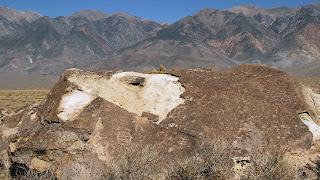Seems like just when you think things are looking up, it's time for another look.
The "obscene" statue that isn't
I recently was pleased to see that the grand jury convened to decide whether an Overland Park Arboretum statue (subject of one of my previous posts) was obscene or not, had taken very little time to decide it is NOT.
Choice: Accept or Reject, by Yu Chang, had been the subject of hot controversy earlier this year, when a group of local fundamentalists aligned with the American Family Association circulated a petition to have it removed. They said it was obscene because the female subject was only partially clothed.
From the beginning, Overland Park officials denied that there was anything "obscene" about this work, and resisted the idea of removing it. The AFA group, however, was able to collect enough signatures to require that a grand jury be convened.
Thank goodness the grand jury had the excellent sense to deal quickly with this nuisance complaint. The group was demanding that the sculpture be removed, but certainly not doing any fundraising to support such a large public expense. I'm sure they aren't planning to pay for the cost of empaneling the grand jury, either.
A horrifying case of theft and vandalism in a sacred place
Not all the recent news about art in public life has been good, however, I was horrified to learn of the recent theft of four ancient petroglyphs from a site near Bishop, CA.
Stealing a petroglyph is no easy feat--and in this case it was done with all the finesse of a smash-and-grab, by a well-organized gang of looters who left ugly gashes, saw cuts and hammer marks--as well as one broken and abandoned petroglyph--in their wake.
The 3500-year-old petroglyphs were part of a site on the National Register of Historic Places, in the Volcanic Tableland area. Greg Haverstock, a Bureau of Land Management archaeologist described it as "the worst act of vandalism ever seen" at the BLM site, in a story posted by the LA Times.
The site is a sacred place to the Paiute-Shoshone tribal members in the area, so it is as if the thieves had looted an ancient temple or cathedral. While not quite on the scale of the destruction of the Buddhas of Bamiyan, this senseless act--priceless treasures hacked to pieces for a potential market value of maybe $500 to $1500--leaves me feeling angry and violated. I can only imagine how the Paiutes and Shoshones must feel.
I don't normally like to use profanity on this blog, but fellow blogger Marina Galperina got it just right when she described these looters as "assholes with chainsaws." I hope the BLM catches up to them quickly, and nails them with every penalty possible.
Meanwhile, happy Thanksgiving.
PHOTO CREDITS: The Fred Blocher photo of Choose: Accept or Reject is from the Kansas City Star's Johnson County 913 magazine. The image of the petroglyph with saw marks is from the Bureau of Land Management, via the New York Daily News. Finally, the hacked-off rock photo came from Maria Galperina. Many thanks to all!
 | |
| Choice: Accept or Reject by Yu Chang |
I recently was pleased to see that the grand jury convened to decide whether an Overland Park Arboretum statue (subject of one of my previous posts) was obscene or not, had taken very little time to decide it is NOT.
Choice: Accept or Reject, by Yu Chang, had been the subject of hot controversy earlier this year, when a group of local fundamentalists aligned with the American Family Association circulated a petition to have it removed. They said it was obscene because the female subject was only partially clothed.
From the beginning, Overland Park officials denied that there was anything "obscene" about this work, and resisted the idea of removing it. The AFA group, however, was able to collect enough signatures to require that a grand jury be convened.
Thank goodness the grand jury had the excellent sense to deal quickly with this nuisance complaint. The group was demanding that the sculpture be removed, but certainly not doing any fundraising to support such a large public expense. I'm sure they aren't planning to pay for the cost of empaneling the grand jury, either.
 | |
| Cement saws left obscene scars in the looters' wake. |
Not all the recent news about art in public life has been good, however, I was horrified to learn of the recent theft of four ancient petroglyphs from a site near Bishop, CA.
Stealing a petroglyph is no easy feat--and in this case it was done with all the finesse of a smash-and-grab, by a well-organized gang of looters who left ugly gashes, saw cuts and hammer marks--as well as one broken and abandoned petroglyph--in their wake.
The 3500-year-old petroglyphs were part of a site on the National Register of Historic Places, in the Volcanic Tableland area. Greg Haverstock, a Bureau of Land Management archaeologist described it as "the worst act of vandalism ever seen" at the BLM site, in a story posted by the LA Times.
 |
| All they left here was an ugly scar. |
I don't normally like to use profanity on this blog, but fellow blogger Marina Galperina got it just right when she described these looters as "assholes with chainsaws." I hope the BLM catches up to them quickly, and nails them with every penalty possible.
Meanwhile, happy Thanksgiving.
PHOTO CREDITS: The Fred Blocher photo of Choose: Accept or Reject is from the Kansas City Star's Johnson County 913 magazine. The image of the petroglyph with saw marks is from the Bureau of Land Management, via the New York Daily News. Finally, the hacked-off rock photo came from Maria Galperina. Many thanks to all!






































